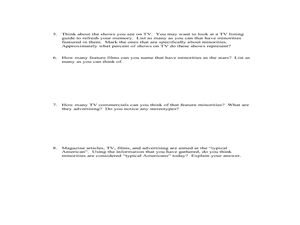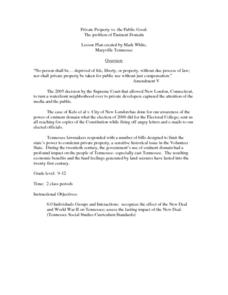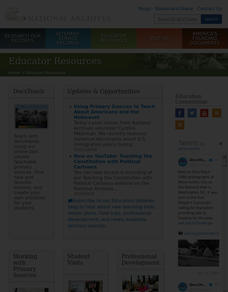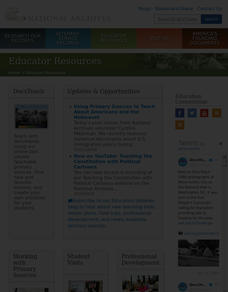Curated OER
George Washington: The Precedent President
Learners investigate precedents set during George Washington's term in office. They conduct Internet research, develop a list of the responsibilities of the President, match Washington's accomplishments with the list, and play a game.
Advocates for Human Rights
The Right to a Clean Environment in the United States
Even if a school has gone digital, chances are there's still plenty of paper being used. The three activities help scholars learn about the environmental impact of paper and another consumer products of their choosing, the issue of...
Constitutional Rights Foundation
Immigration Enforcement Raids
Class groups take on the role of advisors to the Assistant Secretary of the Office of Policy & Planning of ICE. Their charge is to prepare a report for the secretary on the effectiveness of enforcement actions of the ICE in...
Curated OER
Minorities in Mainstream American Society
So many people fought for Civil Rights in the United States. Read about the Civil Rights Act of 1964, and discuss what the act guarantees. Then pass out a slew of magazines and encourage them to observe how often minorities appear in...
School Improvement in Maryland
Analysis of Marbury v. Madison
Should the United States Supreme Court have the power of judicial review? Instructors guide class members through a review of Marbury v. Madison and assist class members in writing a brief of the case. As independent practice,...
Curated OER
Conservation: California Quarter Reverse
Students examine the California quarter reverse and discuss conservation measures. They discover the concept of conservation by a snack-eating experimen and relate it to John Muir's conservation interests. After evaluating the design...
Curated OER
Courts in the Classroom: Ritter v Stanton
Students read the case briefs of Ritter v Stanton. They simulate the trial with classmates taking various parts such as appellant, appellee, bailiff, and justices. After conducting a mock argument, they write their own opinion for the case.
Classroom Law Project
What are some of today’s voting issues? Voting in Oregon, youth vote, and technology
The youth vote. Rock the Vote. Vote-By-Mail. Electronic voting. Class members investigate issues facing today's voters, and the ways they have adapted over the years to optimize voter turnout.
EngageNY
Setting Purpose for Research: What are Fair Working Conditions?
Life may not be fair but working conditions should be. Scholars research working conditions at Wegmans by studying the company website. They complete a working conditions anchor chart and discuss their findings in a think-pair-share...
Curated OER
The Role of the Judiciary in a System of Separation of Powers and Checks and Balances
Students determine the difference between the different branches of government and assess the role of each within the American governmental system.
Constitutional Rights Foundation
Unauthorized Immigration and the US Economy
As part of a study of immigration and the U.S. economy, class members assume the role of newspaper editors to determine which submitted letters to print on their paper's editorial page to present a balanced view of the debate.
Curated OER
Founding Documents of the Peace Corps
Students examine United States foreign policy in the period immediately following World War II through the activities of the Peace Corps.
Curated OER
Participation in Local and State Government
Students investigate the state and local levels of government. They demonstrate an examineing of government at these levels. The identification of officials and resources can be used for assessment.
Curated OER
Maps of Indian Territory, the Dawes Act, and Will Rogers' Enrollment Case File
Young scholars, in groups, analyze one map at a time, first the 1885 map, then the 1891 map. After they have completed the analysis sheets, they compare the two maps and answer questions imbedded in the plan.
Curated OER
Private Property Vs. the Public Good: the Problem of Eminent Domain
High schoolers view video The Electric Valley, discuss film clips and review news articles and other documents pertaining to eminent domain, prepare declarative statement on issue that has pro or con side, and present case to opposing...
Federal Reserve Bank
Quantitative Easing Explained
Dig deeper into the financial crisis of 2008 in the United States and actions taken by the federal government, including the bailouts and purchase of institutions as Fannie Mae and Freddie Mac, to bolster financial market conditions.
Curated OER
Sow the Seeds of Victory!
Students use the National Archives and Records Administration's records to research the history of the U.S. Food Administation.
Curated OER
FDR's Fireside Chat on the Purposes and Foundations of the Recovery Program
Students discuss how they get information on important events or activities that occur in the national government today. They evaluate the New Deal, utilizing document analysis worksheets imbedded in this plan.
Curated OER
Affidavit and Flyers from the Chinese Boycott Case
Students divide into small groups and study one of the three union flyers. Groups share their findings with the whole class and clarify unfamiliar vocabulary terms.
Curated OER
The State vs. The Individual
Students explain the roles of the Fifth and Fourteenth Amendments in regards to due process and eminent domain. They apply their knowledge of the takings issue by creating a political cartoon depicting a takings event.
Curated OER
Court Documents Related to
Students use the National Archives to researcj cout coduments related to Martin Luther King, Jr.
Curated OER
Individual Rights -- Freedom of Speech at School
Students examine their individual rights at a public school. In groups, they identify the most common ways of expressing themselves and why they should limit their speech in public. They compare and contrast two cases in which they...
Curated OER
Sioux Treaty of 1868
Students explore and research the history of Native Americans in North America.
Curated OER
D-Day Message from General Eisenhower to General Marshall
Students use documents in the National Archives of the United States to evaluate the effectiveness of D-Day.





